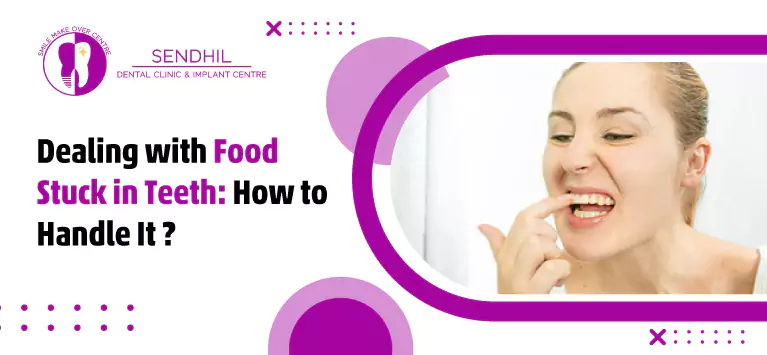
Dealing with Food Stuck in Teeth: How to Handle It ?
Have you ever had that nagging sensation of something stuck between your teeth? It’s annoying and can lead to discomfort and bad breath if not handled promptly. Our blog will explain why food gets stuck, share ways to prevent it, and offer practical advice for removing stuck food debris.

Table of Contents
Understanding Food Stuck Between Teeth
Food stuck in teeth or food traps occurs when small food particles become lodged between your teeth. This will likely happen when you eat sticky or fibrous foods like meat, cheese, bread, or candy. The sticky texture of these foods causes them to adhere to the surfaces of your teeth, and the fibres can become trapped between the gaps in your teeth.
Causes of food trap
Several factors can increase your risk of experiencing food trap:
Misalignment: Crowded or misaligned teeth can create small spaces where food can easily get trapped.
Poor oral hygiene: Regular brushing and flossing help remove food debris from your teeth and gums. Neglecting these practices can increase the buildup of plaque and tartar, narrowing the gaps between your teeth and making them more prone to impaction.
Insufficient saliva: Saliva helps to wash away food debris from your mouth. If you have a dry mouth, you are more likely to experience food stuck in teeth.
Certain medical conditions: Some medical conditions, such as diabetes, Sjogren’s syndrome, and certain medications, can reduce saliva production and increase the risk of food trap.
Consequences of Food Stuck Between Teeth
While food trap is usually harmless, it can lead to several problems if not addressed promptly:
- Pain and discomfort: Food trapped between teeth can cause pain and irritation, especially when biting down or flossing.
- Bad breath: Food debris decomposes over time, producing foul-smelling gases that can contribute to bad breath.
- Tooth decay: Persistent food stuck in teeth can increase your risk of tooth decay, as the bacteria in food debris can feed on the sugars in your teeth, producing acids that damage tooth enamel.
- Gum disease: Food trap can also contribute to gum disease, as the bacteria in food debris can irritate the gums and cause inflammation.
How to Avoid Food Getting Stuck in Your Teeth?
Following these tips can help you avoid food getting stuck in your teeth.
Brush and floss regularly: Brushing and flossing twice daily helps remove food debris from your teeth and gums. Use a soft-bristled toothbrush and fluoride toothpaste to clean your teeth’ surfaces gently. Flossing helps to remove food stuck in teeth, where brushing alone cannot reach.

Eat a healthy diet: Avoid sticky and fibrous foods that are more likely to get stuck in your teeth. Instead, go for fruits, veggies, and whole grains.
Stay hydrated: Drink plenty of water throughout the day to help flush out food debris from your mouth and keep your saliva flowing.
Chew sugar-free gum: Chewing sugar-free gum after meals can help stimulate saliva production and dislodge food debris from your teeth.
Go to your dentist regularly: Regular dental checkups and cleanings can help to identify and correct any problems that may increase your risk of food trap.
Tips to Remove Food Stuck in Teeth
If you do experience food stuck between teeth, there are several ways to remove it:
Dental floss

Gently slide dental floss between your teeth and wiggle it back and forth. This should dislodge the food debris.
Interdental brush
An interdental brush is a small, disposable brush designed to clean the spaces between your teeth. To remove food stuck between teeth, gently rotate the brush between your teeth.
Water flosser
A water flosser can help to blast away food debris from between your teeth using a stream of water.
Toothpick
A toothpick can be used to remove food debris between your teeth carefully. However, be gentle, as using too much force can damage your gums.
Visit your dentist
If you cannot remove the food debris independently, visit your dentist for professional removal.
Conclusion
Food stuck between teeth is a common problem that can be easily prevented and removed. Following the tips can reduce your risk of food trap and maintain a healthy smile. Remember to brush and floss regularly, stay hydrated, eat a nutritious diet, and see your dentist regularly for checkups and cleanings. If you experience food stuck in teeth, don’t hesitate to seek help from a dental professional to prevent any potential complications.




